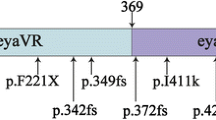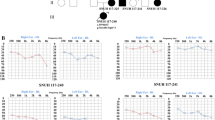Abstract
Background
Hereditary hearing impairment (HHI) is a heterogeneous class of disorders that shows various patterns of inheritance and involves a multitude of different genes. Mutations in the EYA4 gene are responsible for postlingual, progressive, autosomal dominant hearing loss at the DFNA10 locus. EYA4 is orthologous to the Drosophila gene eya (“eyes absent”), a key regulator of eye formation. EYA4 plays an important role in several developmental processes.
Material and Methods
Here we report a Hungarian family displaying sensorineural, progressive hearing impairment. The family comprising four generations with 11 affected and 8 unaffected members was subjected to genome-wide linkage analysis and candidate gene sequencing.
Results
By linkage analysis, the chromosomal region 6q22.3 was shown to segregate with the disease. Mutation analysis of the EYA4 gene, which maps to 6q22.3, revealed an insertion of 4 bp (1558insTTTG) in all affected family members. This insertion creates a frameshift and results in a stop codon at position 379. Hence, nearly the complete “eya homologous region” (eyaHR), which is essential for the protein function, would be deleted in the mutant EYA4 protein if the transcription were found to be stable.
Conclusions
This family is the third one linked to DFNA10 and revealing a mutation in the EYA4 gene. In all three families, the mutations are localized in different regions of the eyaHR, suggesting that this protein contains several functional subregions with different tissue-specific importance.


Similar content being viewed by others
References
Fraser GR. (1971) The genetics of congenital deafness. Otolaryngol. Clin. North Am. 4: 227–247.
Morton NE. (1991) Genetic epidemiology of hearing impairment. Ann N Y Acad Sci 630: 16–31.
Van Camp G, Smith RJ. Hereditary hearing loss homepage. Available from: URL: https://doi.org/dnalab-www.uia.ac.be/dnalab/hhh/. Retrieved August, 2002.
Wayne S, Robertson NG, De Clau F, et al. (2001) Mutations in the transcriptional activator EYA4 cause late-onset deafness at the DFNA10 locus. Hum. Mol. Genet. 10: 195–200.
Hentze MW, Kulozik AE. (1999) A perfect message: RNA surveillance and nonsense-mediated decay. Cell. 96: 307–310.
Borsani G, DeGrandi A, Ballabio A, et al. (1999) EYA4, a novel vertebrate gene related to Drosophila eyes absent. Hum. Mol. Genet. 8: 11–23.
Lathrop G, Lalouel J. (1984) Easy calculations of lod scores and genetic risks on small computers. Am. J. Hum. Genet. 36: 460–465.
Sobel E, Lange K. (1996) Descent graphs in pedigree analysis: applications to haplotyping, locationscores, and marker-sharing statistics. Am. J. Hum. Genet. 58: 1323–1337.
Verstreken M, De Clau F, Schatteman I, et al. (2000) Audio-metric analysis of a Belgian family linked to the DFNA10 locus. Am. J. Otolaryngol. 21: 675–681.
Heanue TA, Reshef R, Davis RJ, et al. (1999) Synergistic regulation of vertebrate muscle development by Dach2, Eya2, and Six1, homologs of genes required for Drosophila eye formation. Genes Dev. 13: 3231–3243.
Bonini NM, Leiserson WM, Benzer S. (1998) Multiple roles of the eyes absent gene in Drosophila. Dev. Biol. 196: 42–57.
Bui QT, Zimmerman JE, Liu H, Bonini NM. (2000) Molecular analysis of Drosophila eyes absent mutants reveals features of the conserved Eya domain. Genetics 155: 709–720.
Heanue TA, Davis RJ, Rowitch, et al. (2002) Dach1, a vertebrate homologue of Drosophila dachshund, is expressed in the developing eye and ear of both chick and mouse and is regulated independently of Pax and Eya genes. Mech. Dev. 111: 75–87.
Xu PX, Adams J, Peters H, Brown MC, Heaney S, Maas R. (1999) Eya1-deficient mice lack ears and kidneys and show abnormal apoptosis of organ primordia. Nat. Genet. 23: 113–117.
Clark SW, Fee BE, Cleveland JL. (2002) Misexpression of the eyes absent family triggers the apoptotic program. J. Biol. Chem. 277: 3560–3567.
Morishita T, Makishima T, Kaneko C, et al. (2001) Deafness due to degeneration of cochlea neurons in caspase-3-deficient mice. Biochem. Biophys. Res. Commun. 284: 142–149.
Takahashi K, Kamiya K, Urase K, et al. (2001) Caspase-3-deficiency induces hyperplasia of supporting cells and degeneration of sensory cells resulting in the hearing loss. Brain Res. 894: 359–367.
Acknowledgments
This study was supported by grants of Else-Kröner-Fresenius-Stiftung, the Ministry of Education, Department for Research in Hungary (TeT 40/2000), and the Hungarian Basic Research Foundation (OTKA-T037255) and Dr. Karl Kuhn-Stiftung. We thank all patients for their cooperation in the study.
Author information
Authors and Affiliations
Corresponding author
Rights and permissions
About this article
Cite this article
Pfister, M., Tóth, T., Thiele, H. et al. A 4bp-Insertion in the eya-Homologous Region (eyaHR) of EYA4 Causes Hearing Impairment in a Hungarian Family Linked to DFNA10. Mol Med 8, 607–611 (2002). https://doi.org/10.1007/BF03402171
Accepted:
Published:
Issue Date:
DOI: https://doi.org/10.1007/BF03402171




